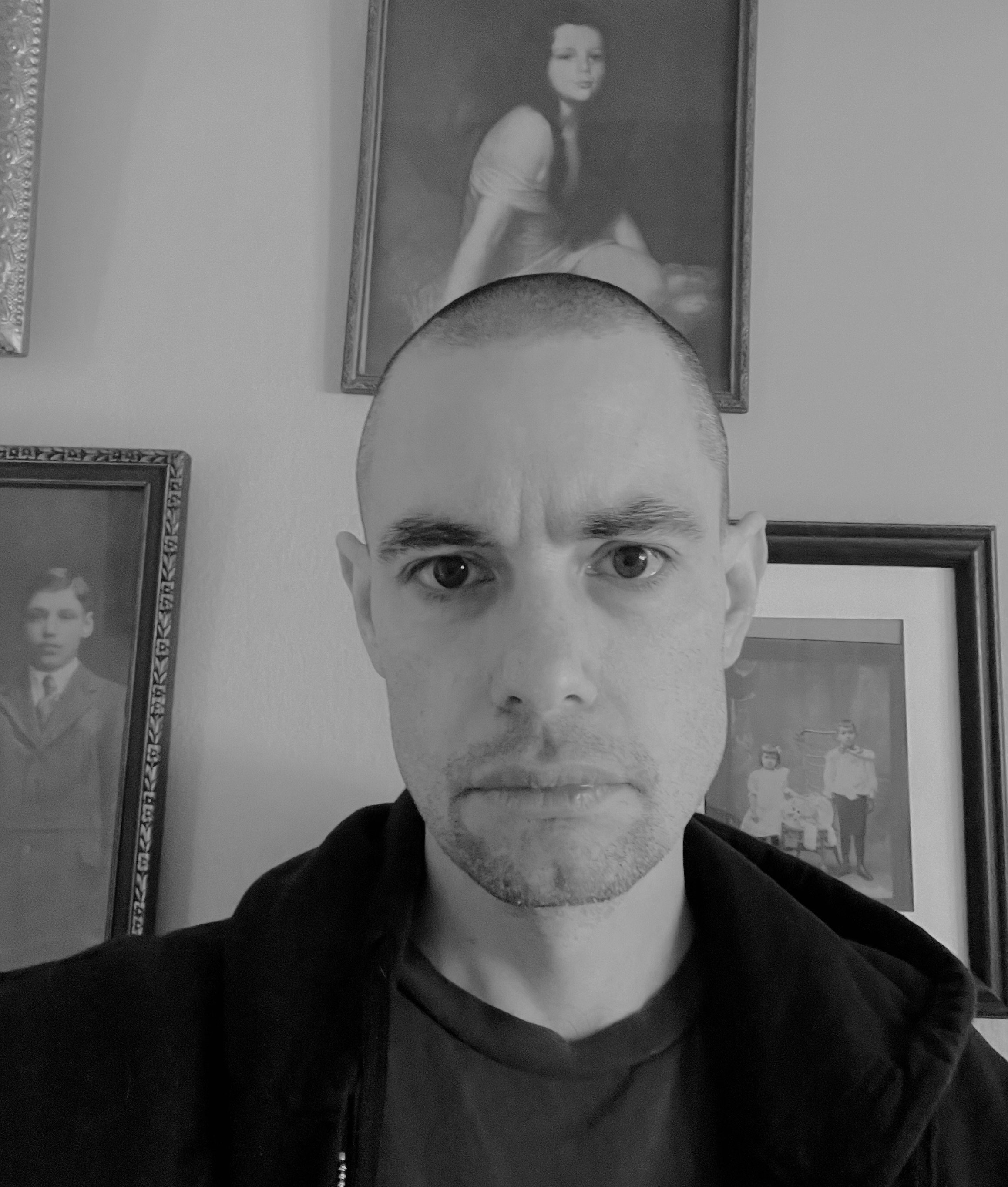INTERVIEW: A Collage Of Infinite Distortions: Robert Kloss on The Genocide House
INTERVIEW: A Collage Of Infinite Distortions: Robert Kloss on The Genocide House
Robert Kloss, “The Genocide House”
Bridge Books
Softcover, $21.99
As the editor of The Genocide House and the live-in partner of its author, Robert Kloss, I feel an aura of intimacy and unfamiliarity around its construction. I have seen Robert typing at his desk every day, working on something (or somethings?). I have seen the stacks of books beside his desk, growing and morphing in theme. I have seen stray print-outs of pages punctuated with — s, filled with notes in Robert’s intimidating hand, his weird, wild script, like words carved out with a knife. But even after reading, re-reading, and re-re-reading The Genocide House, much of Robert’s process remained a mystery to me. So, on an unseasonably hot afternoon in September, I communed with this maker of mysteries.
Meghan Lamb: I’m always curious about the narrative role of titles, both as a device to let potential readers know, “This is the kind of book you can expect to enter into,” and as a different kind of gateway for the author themselves: something that opens up the book for them as they’re writing it. I have a pretty vivid memory of the day you landed on “The Genocide House” as your title (while listening to an Alan Vega track called “IT”). You had this exalted look as you described Vega’s voice growling, “At the genocide house, the killer is close,” and you announced, “I think I have a title for the book.”
So, I’d love if you could begin by telling us a bit about that moment of discovery: what it felt like, where you were at in the book-writing process, and what those lines opened up for you.
Robert Kloss: I was finishing or deep in the process of writing the third section of the novel when I realized I had to use Vega’s lyric. Keep in mind that each of the sections of the Genocide House—the Mary Rowlandson/King Philip section, the Gilles de Rais/H.H. Holmes section, the Leopold and Loeb section, the Oppenheimer section—began life as their own books.
The Genocide House as a title came around the same point I realized that the sections were linked and loosely part of the same long story. Having the title didn’t necessary open up anything for me, in the sense that it didn’t reconfigure my understanding of the text, but it did solidify my understanding of the text as a unified thing—a novel.
Having a title helped me acknowledge the cohesion of the work. Around this time I started toying around with imagery for the cover and interior—antique pornography, mostly, that I smeared around with my limited digital editing tools—although I eventually forgot about these materials. I even set aside The Genocide House—to work on my Leopold and Loeb book, which eventually was collected into The Genocide House.
Something about the title seems vast. I suppose because within such a house there must be many rooms. I’ve thought about how I could have continued writing The Genocide House for another four or eight or twenty years. It’s a book that could achieve an infinite length.
ML: In so many ways, this book feels like a compendium: a compendium of American violence—both violence in the literal sense of war, attrition, murder, enslavement, slaughter, bombing—and the epistemic violence of advertisements, headlines, midcentury table settings, etc. etc.: language that’s designed to worm its way into the brain without the brain noticing or questioning it.
I have a lot of questions under the umbrella of: “How’d you go about writing such an expansive book?”, but let’s start with this question of brain-wormy language. When you were spending time in the Historic Society of Oak Park and River Forest looking at old news clippings, for example, how did you go about collecting bits for future use? And did you have a particular process for arranging all the bits you gradually collected?
RK: This was the first time I’d done research like this—going through stacks of old newspapers rather than settling for Googling or whatever secondary texts I could find—and while I had a sense that I would find some fascinating texture and odd anachronisms, I wasn’t really certain what kind of thing I’d find. The process was mostly intuitive—I just assumed I’d find interesting things and I’d know they would potentially work when I saw them. So I went through old newspapers, physical copies from the 1920s, for about two hours on a few different occasions. I took photos of what I found most interesting and transcribed what was most interesting from there. And then the process of deciding what went into the novel and what was deleted kind of belonged to intuition and rhythm. Some things fit the cadence of the book better than other things. I was really trying to develop a collage with different types of text, so part of assembling the fragments was just patience and trial and error and waiting to see how things came together.
I thought in terms of collage and distortion while weaving this language into my narratives. Some of the text I used is unchanged in terms of the wording (although transformed through context) and some of the text was edited, revised, transfigured. This—I suppose—reflects my general approach to writing about American history.
ML: As someone who has read everything you’ve published (I almost said “everything you’ve written” and immediately recognized what a huge overestimation that was), I feel like I can trace so many career-wide obsessions in this book: a fascination with women in captivity, a fascination with figures who take a kind of strange control through their own subjugation, a fascination with “Blue Beard” figures, a fascination with “great men” who become poisoned with ambition, a fascination with the peculiar vulnerabilities of narcissists…among so many other things.
Did you have a sense of yourself following in these obsessive footpaths as you were writing the book, or did those paths only become clear to you when the book was finished, and you were looking back on them? If they ever became clear to you, that is…and if they didn’t, I’d love to hear about that!
RK: I actually didn’t think about the connection too much. I’m sure I was aware, to an extent, because you would occasionally bring my attention to it. I’d like to think that I’m growing my list of obsessions or varying it just enough. I suppose the “great men” fascination is one I’ve carried my entire life and no matter how I’ve tried to get away from it I continue to come back to it.
In this book it’s in the form of a version of King Philip and “Robert” who is a kind of distorted Oppenheimer and there’s another character who is kind of an amalgam of H.H. Holmes/Gilles de Rais and the men who became incredibly wealthy from the mechanized slaughter of the Chicago stockyards.
My understanding of these people—or my interest in them—has evolved a lot over time, of course, which is maybe why I feel like I can continue returning to this theme without feeling like it’s getting stale.
Now could I say exactly how my feelings have evolved? No. I’d need to remember how I felt 10, 15, 20 years ago. I have such a hazy recollection of these things. How would I feel if I reread the Alligators of Abraham, a book I wrote over 13 years ago? Would I find myself looking in the mirror or would it seem the work of a stranger?
ML: If you could magically give The Genocide House to any dead historic figure with a magical guarantee that they’d read it cover to cover, who would you give it to? And I’m not asking, “Who would you like to hang out with and talk about the book with?”, because I think that’s a different question entirely. I’m just curious who you’d give it to.
RK: I actually thought about this at length. At first I thought I would want to give it to someone who would appreciate it. And someone whose appreciation would bring me some satisfaction.
This is such a peculiar problem because while the book is about past events I also think it’s a modern book, shaped by a modern perspective. I don’t know how well someone who was unfamiliar with the kinds of culture and media that I’ve been exposed to in my life would receive this book. How would someone from 50 or 100 or 150 or 1,500 read such a book? What would Caligula say if forced to read this book (and he was through some magic able to read it)? These minds shaped by entirely other worlds.
But then that seems more interesting in some ways. What an interesting thing misreading a text is. How a mind from another time perceives a text of course gives birth to something new. Our “modern” readings of Oedipus, Hamlet, Pride and Prejudice.
I suppose then my answer is, I’d probably have someone from the far distant past, a pre-historical figure, read it. Some great figure completely forgotten, who once belong to some pre-literate nation or civilization long ago buried by time. I’d have the book read to this person in their own language. I would want to know this person’s reaction.
_
ROBERT KLOSS is the author of four previous novels, including A LIGHT NO MORE and THE WOMAN WHO LIVED AMONGST THE CANNIBALS, both reprinted by Inside the Castle in 2022. He lives in Chicago with his wife, the writer and musician Meghan Lamb, and their cat, Daniel Day-Lewis.
MEGHAN LAMB is the author of MIRROR TRANSLATION (Blamage Books, forthcoming in 2025), COWARD (Spuyten Duyvil, 2022), FAILURE TO THRIVE (Apocalypse Party, 2021) ALL OF YOUR MOST PRIVATE PLACES (Spork Press, 2020) and SILK FLOWERS (Birds of Lace, 2017). Her work has also appeared in Quarterly West, DIAGRAM, Redivider, and Passages North, among other publications. She served as the 2018 Philip Roth Writer-in-Residence at Bucknell University, and currently teaches creative writing through the University of Chicago, Story Studio, and GrubStreet. She is the fiction editor for Bridge (a Chicago-based literary arts publication) and the nonfiction editor for Lover's Eye and Nat. Brut. She creates music, video, and performance art under the name Iron Like Nylon.
Like what you’re reading? Consider donating a few dollars to our writer’s fund and help us keep publishing every Monday.



